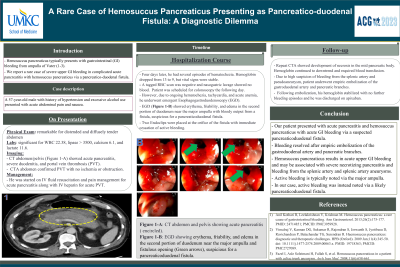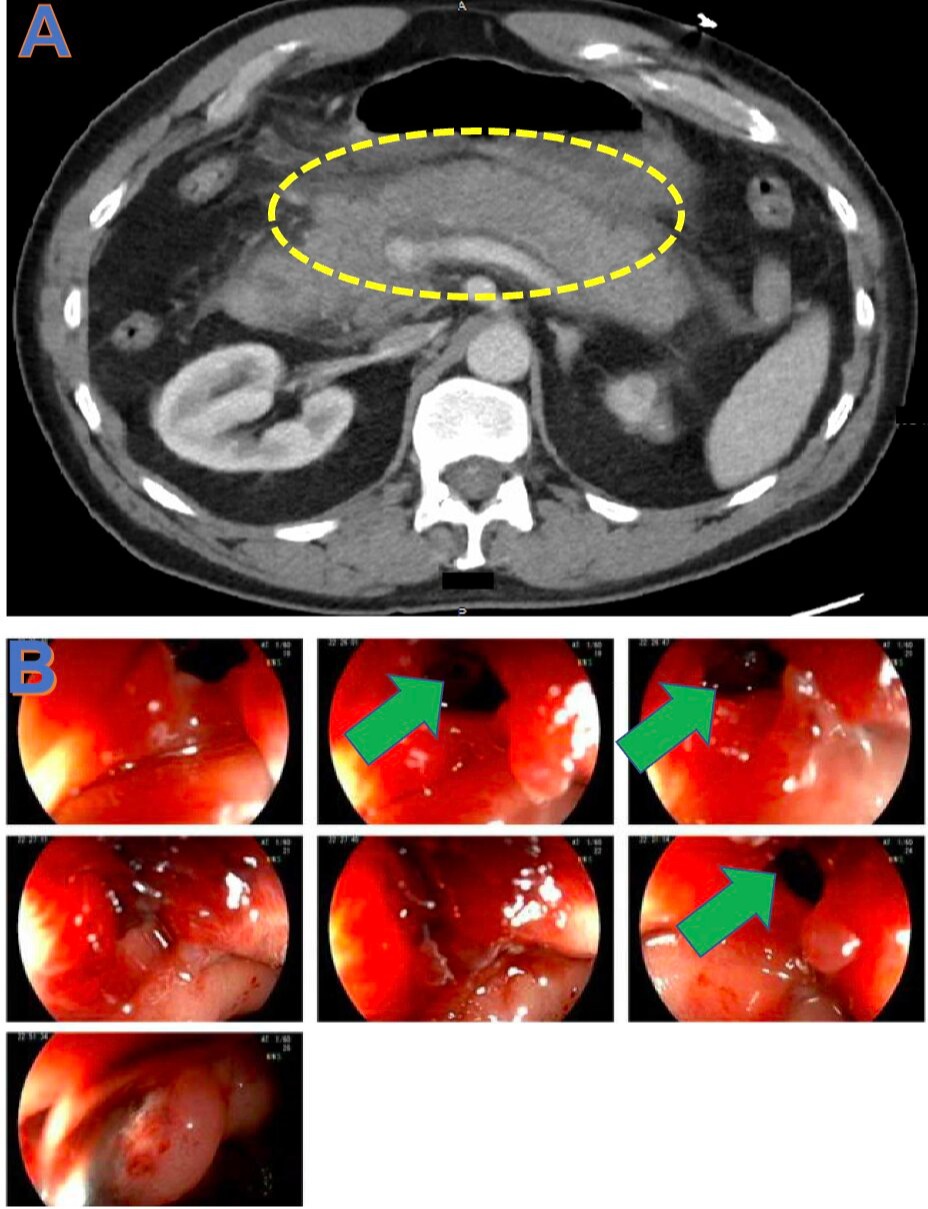Sunday Poster Session
Category: Biliary/Pancreas
P0054 - A Rare Case of Hemosuccus Pancreaticus Presenting as Pancreatico-Duodenal Fistula: A Diagnostic Dilemma
Sunday, October 22, 2023
3:30 PM - 7:00 PM PT
Location: Exhibit Hall


Fouad Jaber, MD
University of Missouri-Kansas City
Kansas City, MO
Presenting Author(s)
Fouad Jaber, MD1, Saqr Alsakarneh, MD1, Tala Alsharaeh, MS2, Kimberly Sanders, MD1, Manasik Abdu, MD3, Mohamed Ismail, DO4, Wael Mohamed, MD1, Stephanie Suddaby, MD5, Wendell Clarkston, MD6
1University of Missouri-Kansas City, Kansas City, MO; 2University of Jordan, Amman, 'Amman, Jordan; 3University at Buffalo-Catholic Health System, Buffalo, NY; 4Rutgers New Jersey Medical School, Newark, NJ; 5Saint Luke's Hospital, Kansas City, MO; 6University of Missouri-Kansas City School of Medicine, Saint Luke’s Hospital of Kansas City, Kansas City, MO
Introduction: Hemosuccus pancreaticus typically presents with gastrointestinal (GI) bleeding from ampulla of Vater. We report a rare case of severe upper GI bleeding in complicated acute pancreatitis with hemosuccus pancreaticus via a pancreatico-duodenal fistula.
Case Description/Methods: A 57-year-old male with history of hypertension and excessive alcohol use presented with acute abdominal pain and nausea. Physical exam was remarkable for distended and diffusely tender abdomen. Labs were significant for WBC 22.38, lipase > 3500, calcium 6.1, and lactate 11.6. CT abdomen/pelvis (Figure 1-A) showed acute pancreatitis, severe duodenitis, and portal vein thrombosis (PVT). CTA abdomen confirmed PVT with no ischemia or obstruction.
He was started on IV fluid resuscitation and pain management for acute pancreatitis along with IV heparin for acute PVT. Four days later, he had several episodes of hematochezia. Hemoglobin dropped from 13 to 9, but vital signs were stable. A tagged RBC scan was negative and nasogastric lavage showed no blood. Patient was scheduled for colonoscopy the following day. However, due to ongoing hematochezia, tachycardia, and acute anemia, he underwent emergent Esophagogastroduodenoscopy (EGD). EGD (Figure 1-B) showed erythema, friability, and edema in the second portion of duodenum near the major ampulla with bloody output from a fistula, suspicious for a pancreaticoduodenal fistula. Two Endoclips were placed at the orifice of the fistula with immediate cessation of active bleeding. Repeat CTA showed development of necrosis in the mid pancreatic body. Hemoglobin continued to downtrend and required blood transfusion. Due to high suspicion of bleeding from the splenic artery and pseudoaneurysm, patient underwent empiric embolization of the gastroduodenal artery and pancreatic branches. Following embolization, his hemoglobin stabilized with no further bleeding episodes and he was discharged on apixaban.
Discussion: Our patient presented with acute pancreatitis and hemosuccus pancreaticus with acute GI bleeding via a suspected pancreaticoduodenal fistula. Bleeding resolved after empiric embolization of the gastroduodenal artery and pancreatic branches. Hemosuccus pancreaticus results in acute upper GI bleeding and may be associated with severe necrotizing pancreatitis and bleeding from the splenic artery and splenic artery aneurysms. Active bleeding is typically noted via the major ampulla. In our case, active bleeding was instead noted via a likely pancreaticoduodenal fistula.

Disclosures:
Fouad Jaber, MD1, Saqr Alsakarneh, MD1, Tala Alsharaeh, MS2, Kimberly Sanders, MD1, Manasik Abdu, MD3, Mohamed Ismail, DO4, Wael Mohamed, MD1, Stephanie Suddaby, MD5, Wendell Clarkston, MD6. P0054 - A Rare Case of Hemosuccus Pancreaticus Presenting as Pancreatico-Duodenal Fistula: A Diagnostic Dilemma, ACG 2023 Annual Scientific Meeting Abstracts. Vancouver, BC, Canada: American College of Gastroenterology.
1University of Missouri-Kansas City, Kansas City, MO; 2University of Jordan, Amman, 'Amman, Jordan; 3University at Buffalo-Catholic Health System, Buffalo, NY; 4Rutgers New Jersey Medical School, Newark, NJ; 5Saint Luke's Hospital, Kansas City, MO; 6University of Missouri-Kansas City School of Medicine, Saint Luke’s Hospital of Kansas City, Kansas City, MO
Introduction: Hemosuccus pancreaticus typically presents with gastrointestinal (GI) bleeding from ampulla of Vater. We report a rare case of severe upper GI bleeding in complicated acute pancreatitis with hemosuccus pancreaticus via a pancreatico-duodenal fistula.
Case Description/Methods: A 57-year-old male with history of hypertension and excessive alcohol use presented with acute abdominal pain and nausea. Physical exam was remarkable for distended and diffusely tender abdomen. Labs were significant for WBC 22.38, lipase > 3500, calcium 6.1, and lactate 11.6. CT abdomen/pelvis (Figure 1-A) showed acute pancreatitis, severe duodenitis, and portal vein thrombosis (PVT). CTA abdomen confirmed PVT with no ischemia or obstruction.
He was started on IV fluid resuscitation and pain management for acute pancreatitis along with IV heparin for acute PVT. Four days later, he had several episodes of hematochezia. Hemoglobin dropped from 13 to 9, but vital signs were stable. A tagged RBC scan was negative and nasogastric lavage showed no blood. Patient was scheduled for colonoscopy the following day. However, due to ongoing hematochezia, tachycardia, and acute anemia, he underwent emergent Esophagogastroduodenoscopy (EGD). EGD (Figure 1-B) showed erythema, friability, and edema in the second portion of duodenum near the major ampulla with bloody output from a fistula, suspicious for a pancreaticoduodenal fistula. Two Endoclips were placed at the orifice of the fistula with immediate cessation of active bleeding. Repeat CTA showed development of necrosis in the mid pancreatic body. Hemoglobin continued to downtrend and required blood transfusion. Due to high suspicion of bleeding from the splenic artery and pseudoaneurysm, patient underwent empiric embolization of the gastroduodenal artery and pancreatic branches. Following embolization, his hemoglobin stabilized with no further bleeding episodes and he was discharged on apixaban.
Discussion: Our patient presented with acute pancreatitis and hemosuccus pancreaticus with acute GI bleeding via a suspected pancreaticoduodenal fistula. Bleeding resolved after empiric embolization of the gastroduodenal artery and pancreatic branches. Hemosuccus pancreaticus results in acute upper GI bleeding and may be associated with severe necrotizing pancreatitis and bleeding from the splenic artery and splenic artery aneurysms. Active bleeding is typically noted via the major ampulla. In our case, active bleeding was instead noted via a likely pancreaticoduodenal fistula.

Figure: Figure 1-A: CT abdomen and pelvis showing acute pancreatitis ( encircled).
Figure 1-B: EGD showing erythema, friability, and edema in the second portion of duodenum near the major ampulla and fistulous opening ( Green arrows), suspicious for a pancreaticoduodenal fistula.
Figure 1-B: EGD showing erythema, friability, and edema in the second portion of duodenum near the major ampulla and fistulous opening ( Green arrows), suspicious for a pancreaticoduodenal fistula.
Disclosures:
Fouad Jaber indicated no relevant financial relationships.
Saqr Alsakarneh indicated no relevant financial relationships.
Tala Alsharaeh indicated no relevant financial relationships.
Kimberly Sanders indicated no relevant financial relationships.
Manasik Abdu indicated no relevant financial relationships.
Mohamed Ismail indicated no relevant financial relationships.
Wael Mohamed indicated no relevant financial relationships.
Stephanie Suddaby indicated no relevant financial relationships.
Wendell Clarkston indicated no relevant financial relationships.
Fouad Jaber, MD1, Saqr Alsakarneh, MD1, Tala Alsharaeh, MS2, Kimberly Sanders, MD1, Manasik Abdu, MD3, Mohamed Ismail, DO4, Wael Mohamed, MD1, Stephanie Suddaby, MD5, Wendell Clarkston, MD6. P0054 - A Rare Case of Hemosuccus Pancreaticus Presenting as Pancreatico-Duodenal Fistula: A Diagnostic Dilemma, ACG 2023 Annual Scientific Meeting Abstracts. Vancouver, BC, Canada: American College of Gastroenterology.
